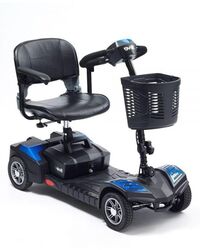Wheeled mobility devices such as scooters, princess chairs and wheeled walking frames are not considered safe for transport in wheelchair accessible taxis and vehicles while the passenger remains seated in them. This is because these types of wheeled mobility devices are structurally different from wheelchairs and a passenger cannot always be safely loaded, restrained and unloaded.
These types of mobility devices may still be carried in an accessible taxi provided that:
• the driver can safely secure the scooter or device using the anchorage points within the allocated floor space in the WAT and
• the passenger can be safely transferred from the mobility device into a fixed seat in the vehicle and use the seatbelt provided.
Background
A passenger who was seated on a mobility scooter was recently injured while being loaded into a Wheelchair Accessible Taxi (WAT).
Safety alert
A passenger must not sit in a mobility scooter (including a mobility aid) while a vehicle is moving. It is also recommended that passengers are not loaded into the vehicle while a passenger is seated on the mobility scooter.
Transporting passengers with a mobility scooter
Wheelchair accessible vehicles are primarily designed to safely transport passengers in wheelchairs. If a passenger is using a mobility scooter, to ensure their safety, they must not sit in a mobility scooter while a vehicle is moving. A passenger who uses a mobility scooter must be seated in a passenger seat, secured with the seatbelt, for the duration of the service.
Transporting passengers while seated in a wheelchair
Passengers can only travel while seated in their wheelchair if the wheelchair meets the requirements under the relevant Australian/New Zealand Standards (AS/NZS) for transporting passengers in wheelchairs. The relevant standards are set out in clause 10 of the Point to Point Transport (Taxis and Hire Vehicles) Regulation 2017.
Service providers and drivers should be aware of the relevant Standards, and if the wheelchair does not meet the Standards for transporting passengers in wheelchairs, then the passenger must be seated in a passenger seat with a seatbelt, and the wheelchair appropriately and safely secured for the journey.
To understand the requirements better, please see our Quick Reference Guide.
Responsibilities
Drivers have a responsibility to ensure that they are providing a safe service. All drivers of WATs must know how to, and must be able to:
- correctly load a wheelchair into their vehicle
- correctly secure a wheelchair once it is in their vehicle
- safely and correctly unload a wheelchair from their vehicle.
Taxi Service Providers, facilitators, and Booking Service Providers must ensure their drivers are trained and competent in the three activities listed above. They must also ensure their drivers are trained and competent in communicating with, and assisting, passengers with differing levels of ability. To ensure passenger safety, WAT drivers should undertake ongoing WAT competency training.
Service providers also need to record in their Safety Management System what they do
to keep passengers and drivers in WATs safe.
Links for further information
Wheelchair Accessible Taxis FAQs
Wheelchair Accessible Taxi licences
Quick Reference Guide
